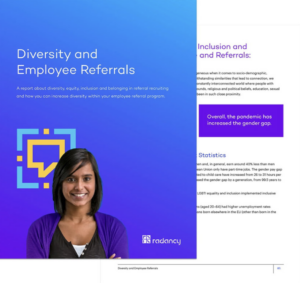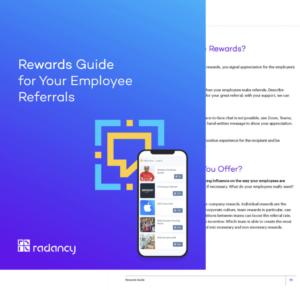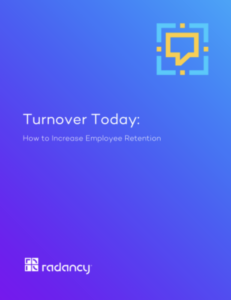In a world where companies constantly search for talent, digital employee referral programs have become an essential tool. But behind these programs often lie unexpected psychological and social dynamics that go beyond the mere act of referral. Let’s take a look at some of these lesser-known aspects.
1. The Principle of Reciprocity
Reciprocity is a fundamental component of human interactions and plays an important role in the dynamics of employee referral programs. This principle describes how people tend to reciprocate the help and support they receive and is relevant in both personal and professional relationships.[1]
The reciprocity principle is particularly important in employee referral programs. When employees recommend someone for a position in the company, they actively contribute to the company’s success. This action is often recognized and valued by the company, which can lead to stronger employee loyalty to the company. Such activities that go beyond regular work tasks can increase employees’ sense of belonging and commitment to their company.
Recommending candidates from your own network can also bring personal satisfaction, as it gives employees the feeling that they are making a valuable contribution to the team’s success. However, caution is required: If employees do not feel valued in their referral efforts, this can lead to frustration. It is therefore crucial for companies to design referral programs fairly and transparently and to acknowledge employee support appropriately.
2. Group Dynamics and Social Identity in Employee Referral Programs
Anyone involved in referral recruiting should be familiar with the concept of social identity and the impact of group dynamics, particularly in relation to diversity in organizations. A key element of this is the natural tendency to favor people from one’s own social network, a behavior that has far-reaching implications for workforce structure.
Social identity theory, developed by Tajfel and Turner (1979), provides a valuable framework for understanding how people define their belonging to social groups and how this belonging influences their behavior. This theory shows that people have a preference for members of their own group[2], which is also reflected in employee referrals. Employees tend to recommend people who are similar to them in aspects such as cultural background, education or other social characteristics.
These social similarities can often influence hiring decisions in organizations, potentially limiting diversity in the workplace. A workforce made up predominantly of people who come from similar social networks can result in a homogenous group that offers less diverse perspectives and experiences.
Companies are therefore faced with the challenge of developing a balanced strategy that both leverages the benefits of existing networks and promotes diversity. It is crucial that HR teams are aware of this dynamic. By doing so, they can take proactive steps to ensure that their employee referral programs do not unintentionally harm diversity in the workplace, but at best enhance it. This can be achieved, for example, through the introduction of targeted policies and communication campaigns.
Want to know how you can use employee referrals to increase diversity in your company? Download our free whitepaper “Diversity and Employee Referrals”.
3. Trust in the Technology
When it comes to whether or not employees want to use a digital referral platform, trust plays a very important role. According to management research, trust is based on three things:
- Is the platform reliable?
- Does the program benefit the users?
- How honest or ethical is the platform?[3]
If a platform performs well in these areas, users will trust it more and be more willing to use it.
Further studies show that trust online is not only created through the direct use of a program or system, but also through the feeling of security, data protection, ease of use and available help in the event of problems.[4] These points are also important for digital referral programs.
Therefore, if you want to implement a digital employee referral program, you should make sure that it is intuitively designed and easy to use. Security features, clear data protection rules, ease of use and good customer support ensure that users feel secure and trust the platform.
4. The Psychology of Reward
The psychology of rewards plays a crucial role in the design and effectiveness of employee referral programs. Referral programs typically use rewards to incentivize employees for their referrals. This, in turn, can increase motivation and engagement in the workplace. To better understand this relationship, it is helpful to look at the research behind it:
For example, a meta-analysis examined how extrinsic rewards (i.e. rewards from outside, such as money or gifts) influence motivation. The research results show that extrinsic rewards are particularly motivating when they are perceived as recognition of competence and performance. If, on the other hand, rewards are perceived as control or pressure, they can undermine motivation.[5]
For the design of employee referral programs, this means that rewards should be carefully selected and used to achieve the desired effects. Programs that use rewards to recognize valuable contributions to the company’s success can have a positive impact on employee motivation. It is important that such programs respect the autonomy of employees and recognize their contributions in a way that encourages their motivation and commitment.
Want to read more about how you can best reward employee referrals? Get our free “Rewards Guide for Your Employee Referrals”.
5. Motivation and Employee Retention
Employee referral programs are not only a smart way to bring new talent on board, but they also have an impact on existing employees’ sense of belonging. Imagine if your employees not only felt part of the team, but also as valued contributors to the company’s success. This is exactly what research suggests: Employees who feel that their contribution is valued develop a stronger bond with the company. Not only are they more motivated to work towards common goals, they also remain loyal to the company.[6]
A closer look at the research on employee retention shows how important autonomy and a simultaneous connection to the team are for motivation.[7] Employee referral programs can shine here by not only rewarding individual contributions, but also creating an environment that encourages the workforce to be proactive and see themselves as an important part of the whole. Involving employees in the recruitment process creates a sense of inclusion and ownership within the company. In this way, you promote a culture of support and appreciation, which is essential for long-term employee retention.
Download our whitepaper “Understanding Employee Turnover: Strategies for Long-Term Retention” for more valuable solutions for a satisfied and engaged workforce.
Conclusion
Employee referral programs are a valuable tool for attracting new talent and promoting a positive working environment. They reflect the corporate culture and have a significant impact on employee satisfaction and retention. In order to design their referral recruiting effectively, it is helpful for companies to understand the psychological and social dynamics behind these programs.
It is crucial that companies take a proactive role and regularly adjust their employee referral programs to ensure a fair, transparent and inclusive experience. This includes clear guidelines, promoting diversity and an environment where all employees feel valued.
The success of employee referral programs depends on an organization’s ability to create an environment that fosters recognition and diversity. By integrating these values, organizations can not only improve their talent acquisition, but also build an engaged, motivated and diverse workforce.
Discover the power behind effective employee referral programs and how they can transform your business. Book a free demo now and experience first-hand how Radancy’s employee referral program not only improves talent acquisition, but also strengthens employee retention and fosters an inclusive work environment. Take the first step towards a more engaged and diverse team – book a demo today!
Sources:
[1] Gouldner, A. W. (1960). The Norm of Reciprocity: A Preliminary Statement. American Sociological Review, 25(2), 161–178. https://doi.org/10.2307/2092623
[2] Tajfel, H., & Turner, J. C. (1979). An integrative theory of intergroup conflict. In W. G. Austin & S. Worchel (Eds.), The social psychology of intergroup relations (pp. 33-47). Brooks/Cole.
[3] Mayer, R. C., Davis, J. H., & Schoorman, F. D. (1995). An integrative model of organizational trust. Academy of Management Review, 20(3), 709-734. https://doi.org/10.2307/258792
[4] Stewart, K. J. (2003). Trust transfer on the World Wide Web. Organization Science, 14(1), 5-17. https://doi.org/10.1287/orsc.14.1.5.12810
[5] Deci, E. L., Koestner, R., & Ryan, R. M. (1999). A meta-analytic review of experiments examining the effects of extrinsic rewards on intrinsic motivation. Psychological Bulletin, 125(6), 627-668. https://doi.org/10.1037/0033-2909.125.6.627
[6] Eisenberger, R., Huntington, R., Hutchison, S., & Sowa, D. (1986). Perceived organizational support. Journal of Applied Psychology, 71(3), 500-507. https://doi.org/10.1037/0021-9010.71.3.500
[7] Ryan, R. M., & Deci, E. L. (2000). Intrinsic and extrinsic motivations: Classic definitions and new directions. Contemporary Educational Psychology, 25(1), 54-67. https://doi.org/10.1006/ceps.1999.1020























